1/23/2008 New Portfolio: San Francisco Industrial
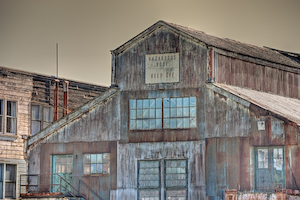
This portfolio features shots with the Canon 1Ds Mark III (and Nikon D3).
12/26/2007 Second Gallery posted
We use the 1Ds now for our normal work. There is a first dust spot that does not get cleaned by the camera (after 1,000 shots). Only an issue in clear skies and nothing to bother about (One click in CS3).
Here is our new gallery:
1Ds Mk III Gallery #2
We photograph always using our own "Capture more Light" technique. This means taking 3 bracketed pictures at the highest speed of the camera.
When we return we sort out all the RAW files we don't need to free up some disk space.
Now all our images get some treatment of our new Detail Extractor Photoshop script. Yes we plug our tool (supports DOP) but we created it for our own work in the first place.
12/15/2007 Dealing with High ISO images
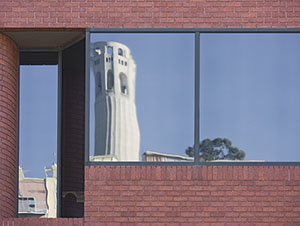
We wrote an article that covers how to deal with high ISO images: "Capture more Light: Mix & Match Sample Workflow".
12/11/2007 First Gallery posted
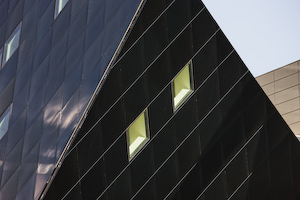
We had two real photographic sessions with the 1Ds Mark III so far:
- Monterey/Carmel
- Downtown San Francisco
We photograph always using our own "Capture more Light" technique. This means taking 3 bracketed pictures at the highest speed of the camera. 5 frames per second does the job but we would not mind if it would be much faster. Feels quite a bit slower than the 10 fps of the Canon 1D Mark III.
The real downside of this method is that we produce a lot of image data (we have now a Kensington 16GB card in the camera). For the 1D Mark III (10MP) we get about 33MB for a 3 shot bracket and now for the 1Ds Mark III we get about 64MB for 3 shots. This means we inspect the pictures after the shoot and keep only all 3 shots in case we want to merge the exposures later. Otherwise we find the best shot and delete the other exposures to free our disks.
Here is our first gallery from the 1Ds Mark III.
12/8/2007 RRS L-Bracket
All our main cameras are equipped with Really Right Stuff L-Brackets (more on plates and brackets). We now also have the right version for the 1Ds Mark III.
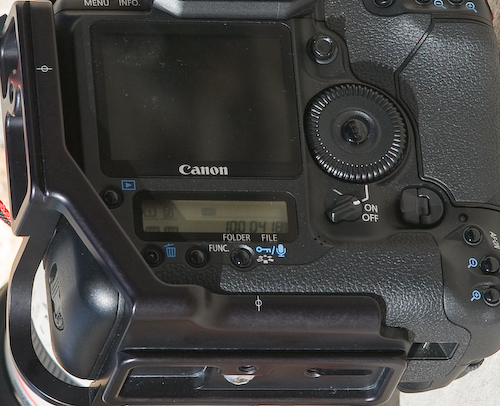
RRS L-Bracket
12/4/2007 Early experiments with 1Ds III and Super-resolution
If you have not heard about PhotoAcute and Super-resolution please read this article.
Note: PhotoAcute does not have proper profiles for the 1ds3 at this point in time. We experimented with some 1Ds Mark II profiles in our test.
At our Alviso test session (Jack Flesher and Uwe Steinmueller) I used Jack's Canon 85mm f/1.8 lens and shot brackets freehand with the 1Ds Mark III (3 shots, -1 1/3, 0, + 1 1/3EV). Finally I only used 2 photos (3 did not align well, maybe a profile issue) and still insisted in PhotoAcute to create a Super-resolution image (at least 4 pictures are recommended). The resulting DNG file was opened in ACR 4.3 and then down sampled to 7000x4653 (about 32MP). The DNG file PhotoAcute creates is a file of 84MP (4x the resolution of the camera).
For your fun and inspection we post the resulting image as JPEG. As mentioned these are early experiments.
12/4/2007 Some comparisons to the 5D and 1Ds Mark II
With our friend Jack Flesher we did some comparison shots with the 5D and 1Ds Mark II. Jack shares his subjective findings here.
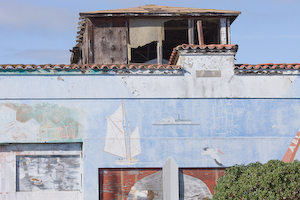
As a bonus you find also a shot of the same scene with the Leica M8.
12/2/2007 Lenses matter
We tested now the 1Ds Mark III with the following two lenses:
- Canon 70-200mm f/4L IS (considered an excellent tele zoom)
- Canon 135mm f/2L (one of Canon's sharpest lenses, read our review)
Note: This time we shot handheld and this should be an advantage for the IS zoom.
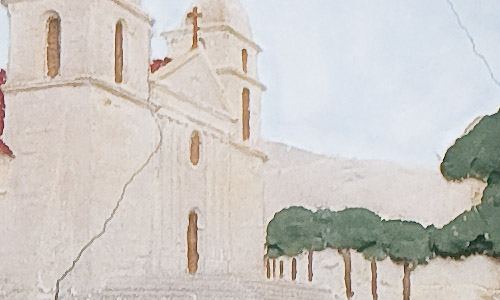
70-200 f/4L IS at ISO 400 (Highlight priority on)
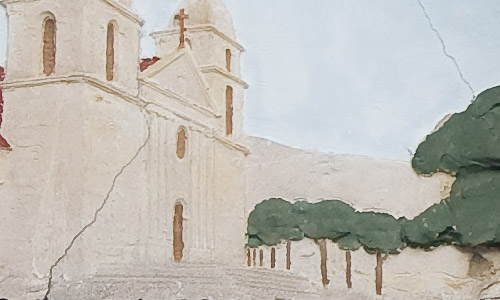
135mm f/2L at ISO 400 (Highlight priority on)
We even applied less sharpening to the 135mm lens shot and still it wins hands down.
For your own inspections we post also the RAW files:
Note: We had again overcast. This is a situation where you want as much contrast from your lens as you can get. The 135mm f/4L delivers just that.
12/2/2007 Diary Start
We won't spend a lot of time talking about the new body because it is essentially the same as the Canon 1D Mark III. We use the 1D Mark III now for about six months and like this body a lot (especially the battery).
Note: We know about the 1D Mark III AF issues but never had any issues with our camera and our style of photography.
We own the 1Ds and also the 1Ds Mark II (always late to sell gear :-)). The main improvements for us are:
- Dust removal (we have very good experience with the 1D Mark III and 40D). With the old 1Ds II the dust was always a major hassle.
- Much better battery
- Slightly lighter
- Live view can be nice at times and helps with mirror lockup
- Improved dynamic range (at least we hope). The 1D Mark III and 40D showed big improvements
- Better menu structure (especially "My Menu")
- No personal functions that requite a PC connection
- 14 bit data
- 5 frames per second (makes it usable for our "High Speed HDR" technique that we teach in our workshops)
- The 3" LCD which is now standard on new Canon cameras
The histogram
Same comment as for the Canon 1D Mark III: Histogram shows now all 3 channels and the luminance histogram at the same time. So far so good. Unfortunately it is hard to see whether the data clip because the background of the histogram is dark gray and the rest on the LCD is black. It would be much easier to check the histogram if there would be a clear visible line around the histogram area.
Are these images soft?
With our images we had some struggle in the beginning. They looked soft with settings we are used to for the Canon 1D Mark III. This was kind of the same when we started using the 1Ds Mark II. It turned out that we need much more sharpening to bring these images to live at 100% magnification. There are quite a few possible reasons for this initial softness:
- AA filter used (Leica M8 images always look sharper than comparable images of other DSLRs at 10MP)
- We used the 24-105 f/4 IS lens which we always found sharp (of course not at a level of the 135mm f/2 or 50mm f1.2 see here)
- At 21MP the pictures show much easier any sort of motion blur
- Images with more pixels need always more sharpening (if the initial image has about the same "softness")
Now we use a stronger sharpening in Lightroom 1.3 or ACR 4.3 and found that these images can take quite a strong sharpening before the quality degrades. For us the problem is solved.
Note on Chromatic Aberrations (CA)
Images with this resolution show more into your face any CA flaws. Fortunately they can easily be removed in Lightroom or ACR.
Los Gatos test shots
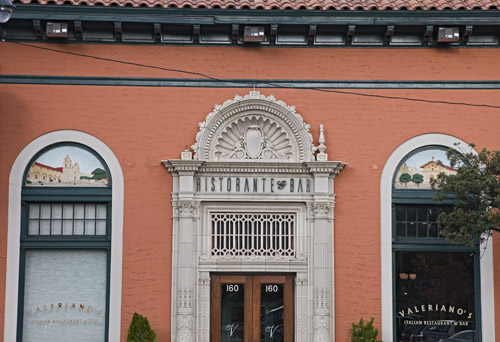
Ristorante @ISO 100
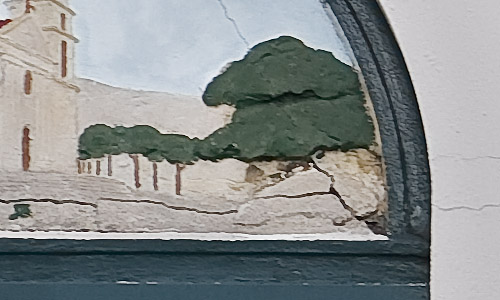
Crop @100% magnification
We used for this test our EF 24-105mm
f/4L IS USM zoom. We found that our trusty 24-70mm f/2.8 lens produces more chromatic aberrations. We think the photos is as expected. As mentioned we used strong sharpening in ACR and later in Photoshop (EasyS). Please note what small area in the final image is represented by this crop.
You can download the original RAW from here (>25MB).
Note: Remember that the service we provide is financed
by selling our ebooks and PS
tools. Also direct donations are welcome.
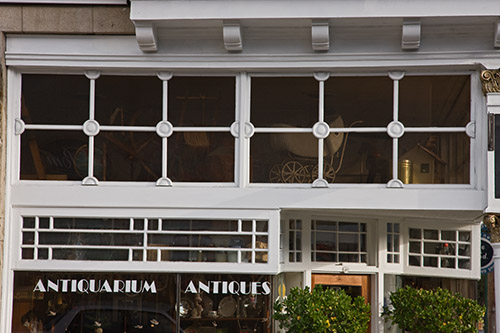
Antique store @ ISO 400
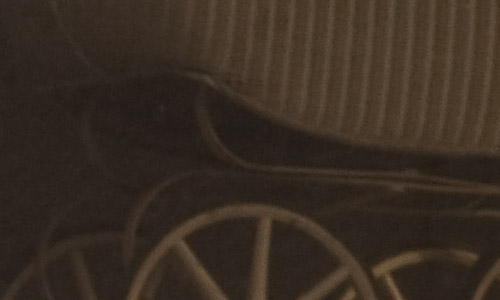
@ 100% magnification
Shadow noise at ISO 400 is ok and as expected from a camera of this class.
ISO Test
The light was very different from our usual ISO tests (Overcast sky, normally we have the blue sky reflected in the window).
We skip from now on ISO 100 because all cameras are already very good at ISO 200 (not P&S cameras of course)
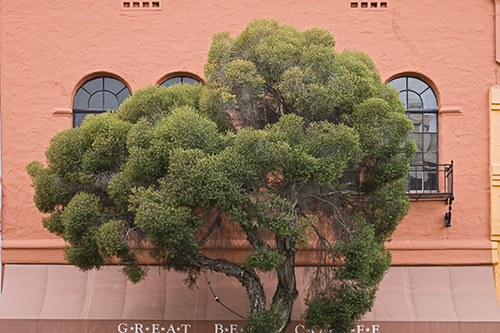
Bear Coffee Shop
Canon EOS 1Ds Mark III |
| |
 ISO
200 |
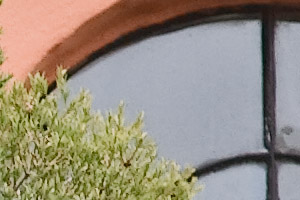
ISO 400 |
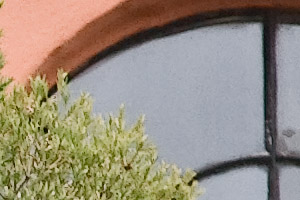
ISO 800 |
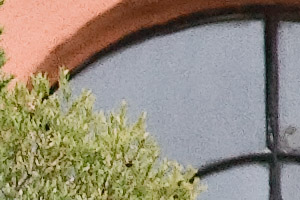
ISO 1600 |
Remember all these shots are with luminance noise removal off in camera
and raw converter (color noise removal was at default). ISO 200 very smooth with virtually no noise.
ISO 400 shows a bit of noise that should be no problem. ISO 800 shows still manageable noise .
At
1600 the noise is too much for our taste. We would not use use ISO 1600 in most cases because it is like losing resolution.
Note about high ISO noise: Many people ask why they should worry about noise at ISO 800 or more if they only use 400 ISO at max. This is of course a good question. In the past we did not care either. Then we changed our photographic style and make now often use of Tonemapping (learn more about HDR and Tonemapping). During this process we brighten the shadows and this brings out the noise otherwise seen at way higher ISO. It often starts to matter at even ISO 200 photos.
Note about Frame Rate: We hardly photograph action and still we find the high frame rate very interesting. Why? We shoot high speed exposure brackets freehand. Please read this article for our motivation behind high speed brackets. We find that the 1Ds Mark III works for our new technique very well.
First conclusions
- Once we solved the "softness" issue we started to like this camera
- 21MP is a nice upgrade but not the main story (compared to 16MP of the 1Ds Mark II)
- If dust removal works as well as on the Canon 1D Mark III then this would be very good news
- 5 fps is a lot for a 21MP camera and should do four our HS HDR work
- Shutter sound could be lower
- We plan to spend more time to check into noise and dynamic range
- We would like to have to option to use the 1Ds Mark III without an AA filter
We will only do a few more tests and then start using the 1Ds Mark III for our daily work. When Bettina and I photograph together our second camera will be the 1D Mark III or 40D - we like both cameras a lot). This will hopefully allow us to compare them side by side and see whether the higher resolution of the 1Ds Mark III is addictive :-).
Other Reviews
|

